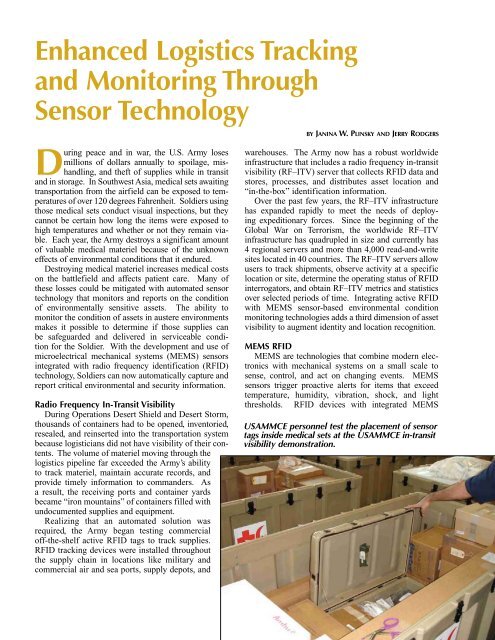Do Stryker Brigade Combat Teams Need Forward Support ...
Do Stryker Brigade Combat Teams Need Forward Support ...
Do Stryker Brigade Combat Teams Need Forward Support ...
Create successful ePaper yourself
Turn your PDF publications into a flip-book with our unique Google optimized e-Paper software.
Enhanced Logistics Tracking<br />
and Monitoring Through<br />
Sensor Technology<br />
During peace and in war, the U.S. Army loses<br />
millions of dollars annually to spoilage, mishandling,<br />
and theft of supplies while in transit<br />
and in storage. In Southwest Asia, medical sets awaiting<br />
transportation from the airfield can be exposed to temperatures<br />
of over 120 degrees Fahrenheit. Soldiers using<br />
those medical sets conduct visual inspections, but they<br />
cannot be certain how long the items were exposed to<br />
high temperatures and whether or not they remain viable.<br />
Each year, the Army destroys a significant amount<br />
of valuable medical materiel because of the unknown<br />
effects of environmental conditions that it endured.<br />
Destroying medical materiel increases medical costs<br />
on the battlefield and affects patient care. Many of<br />
these losses could be mitigated with automated sensor<br />
technology that monitors and reports on the condition<br />
of environmentally sensitive assets. The ability to<br />
monitor the condition of assets in austere environments<br />
makes it possible to determine if those supplies can<br />
be safeguarded and delivered in serviceable condition<br />
for the Soldier. With the development and use of<br />
microelectrical mechanical systems (MEMS) sensors<br />
integrated with radio frequency identification (RFID)<br />
technology, Soldiers can now automatically capture and<br />
report critical environmental and security information.<br />
Radio Frequency In-Transit Visibility<br />
During Operations Desert Shield and Desert Storm,<br />
thousands of containers had to be opened, inventoried,<br />
resealed, and reinserted into the transportation system<br />
because logisticians did not have visibility of their contents.<br />
The volume of materiel moving through the<br />
logistics pipeline far exceeded the Army’s ability<br />
to track materiel, maintain accurate records, and<br />
provide timely information to commanders. As<br />
a result, the receiving ports and container yards<br />
became “iron mountains” of containers filled with<br />
undocumented supplies and equipment.<br />
Realizing that an automated solution was<br />
required, the Army began testing commercial<br />
off-the-shelf active RFID tags to track supplies.<br />
RFID tracking devices were installed throughout<br />
the supply chain in locations like military and<br />
commercial air and sea ports, supply depots, and<br />
ARMY LOGISTICIAN PROFESSIONAL BULLETIN OF UNITED STATES ARMY LOGISTICS<br />
by janina W. pLinSKy and jerry rodGerS<br />
warehouses. The Army now has a robust worldwide<br />
infrastructure that includes a radio frequency in-transit<br />
visibility (RF–ITV) server that collects RFID data and<br />
stores, processes, and distributes asset location and<br />
“in-the-box” identification information.<br />
Over the past few years, the RF–ITV infrastructure<br />
has expanded rapidly to meet the needs of deploying<br />
expeditionary forces. Since the beginning of the<br />
Global War on Terrorism, the worldwide RF–ITV<br />
infrastructure has quadrupled in size and currently has<br />
4 regional servers and more than 4,000 read-and-write<br />
sites located in 40 countries. The RF–ITV servers allow<br />
users to track shipments, observe activity at a specific<br />
location or site, determine the operating status of RFID<br />
interrogators, and obtain RF–ITV metrics and statistics<br />
over selected periods of time. Integrating active RFID<br />
with MEMS sensor-based environmental condition<br />
monitoring technologies adds a third dimension of asset<br />
visibility to augment identity and location recognition.<br />
MEMS RFID<br />
MEMS are technologies that combine modern electronics<br />
with mechanical systems on a small scale to<br />
sense, control, and act on changing events. MEMS<br />
sensors trigger proactive alerts for items that exceed<br />
temperature, humidity, vibration, shock, and light<br />
thresholds. RFID devices with integrated MEMS<br />
USAMMCE personnel test the placement of sensor<br />
tags inside medical sets at the USAMMCE in-transit<br />
visibility demonstration.<br />
13







